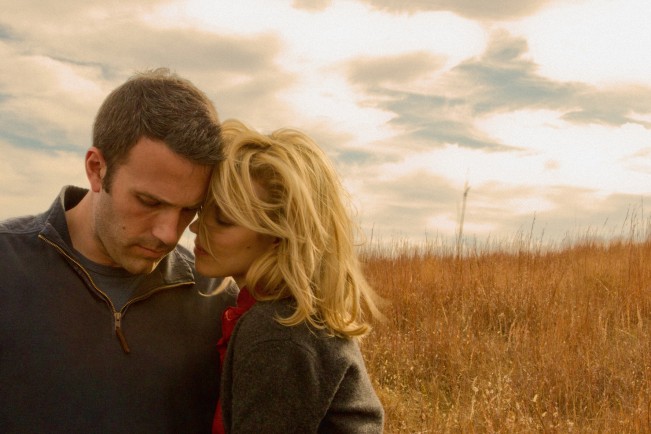

By Ray Pride Pride@moviecitynews.com
TIFF12 Review: To The Wonder
“I’d like to have him here to introduce the film,” TIFF artistic director Cameron Bailey said before the second public showing of To The Wonder, at the 1,700-or-so-seat Princess of Wales Theater, “but that’s not going to happen.” (A knowing ripple of laughter from the packed-to-the-second-balcony audience.) Setting the stakes high, Bailey also said of the reticent filmmaker, “There is no one greater working in cinema now.”
To the Wonder is immediately and consistently recognizable as a Terrence Malick film. Its romance, between a cold man and two beautiful women, is conveyed through more implication and indirection than any movie in his career. It’s 116 minutes of epic languor. Once again, Malick works with multiple narrators. One of the more memorable scraps of mutter is the phrase “an avalanche of tenderness.” More common are phrases that recall The Tree Of Life‘s approximations of raptures, such as “I in you, you in me.” To The Wonder is a further distillation of Malick’s mission to convey emotion through sensation and repetition of gesture, and thoughts privileged aloud as ululations of desire. (Coincidentally, Harmony Korine’s Spring Breakers makes similar experiments.) Hushed and murmurous, To The Wonder, while reportedly steeped in autobiographical resonance for the suddenly prolific filmmaker, may, for many viewers, be only a succession of bits of B-roll impressionism. (End credit is given for images that are outtakes from The Tree of Life.) The presence of Joerg Widmer’s Steadicam is pronounced: throughout, the camera not so much glides as it slides and puppy-dogs behind and beside the action, as elusive as the characters’ flashes of hummingbird-sudden emotion.
After a swoony rush through France, spooning at each other and for a video camera, usually standing at right angles to each other for the image to swirl around them while laughing or scuffling and even walking on melty ice, Neil (Ben Affleck) takes his inamorata, Marina (Olga Kurylenko), from Paris to Oklahoma, along with her 10-year-old daughter, and later, during a split, runs into Jane (Rachel McAdams), a woman he knew from childhood. Neil is a kind of mud doctor, checking out the earth underneath, as well as surface water and excavations, measuring disturbances that construction and drilling have made in crust and muck and aquifer. He can calculate how man has poisoned the Earth but not how he poisons his loves. Malick uses Affleck’s strong face as smooth crag rather than for performance; he has few lines, none memorable. Marina, on the other hand, is continually dancing and jumping, and there are hints of her aptitude with instruments and music and likely problems with depression. Javier Bardem is in the margins as Father Quintana, a gloomy priest who ministers to the poor, broken, malformed and otherwise stricken, hands brushing their faces. He offers advice like “A husband is to love his wife as Christ loved the church,” but that note doesn’t seem much help to Neil.
The expectedly gorgeous photography is in unfiltered natural light, flattering these three faces, especially McAdams. Eyes. Skin. Flickers of repose. The film’s most tender moment, even aside from caresses in chaste nudity that are new to Malick, is between Neil and Jane. In a too-brief passage, Jane, who appears to be a horse rancher, finds herself and Neil brushing against each other in a large field against empty horizon right up next to a herd of brown bison amid rustling grasses, as if grass were ever still when a camera is directed its way.
The wind buffets Jane’s loose hair, she and Neil kiss, and a single, ready tear trembles on her cheek, matching a pearl earring to the side of her face, the side of the frame. “I love you,” she whispers and all is good, before Malick is quickly back to God, wind, sun, murmuring. The longest bit of dialogue is in Italian, from a visiting female friend of Marina’s, but Jane’s explanation of why her husband’s gone, wryly tossed aside—”Student loans, gambling debts and this ranch that’s falling apart”—is the closest Malick’s words come to the likes of “She was a good frien’ of mine. I hoped she would meet a charactah,” as at the end of Days of Heaven. (That Malick was so long ago.) In its own way, this is a silent film, but with detailed sound design, heavy on agitated birds, and a never-ending musical undercurrent, with only a few dozen words spoken by characters while on camera.
To The Wonder is also very damp, filled with free association of wet, glinting imagery, akin to the sleek streets of Michael Mann’s movies, but omitting the streets and going straight to the source of life, l’eau de vie. To The Wonder can be read as about pity and the hope of forgiveness, but its heaviest impression is of rain, rains, raining, streams and rainingness.
The Oklahoma suburbs, and the impoverished side of Malick’s hometown of Bartlesville draws an Eggleston-like gaze. Malick and Emanuel Lubezki are eager to describe oddities, drawn to cracked things, weathered houses, faces that are even more weathered, as if a corrective from the way the camera gazes upon Adams and Kurylenko, their faces and their bodies: they are ennobled. But beauty of one kind or another is everywhere: A half moon loiters above contrails above high-tension electrical transmission towers that align with rows of houses. Another contrail of luminescent white is like a gash off the blue enamel of the sky. Marina’s daughter exclaims in French in a supermarket, “It’s super-clean, everything is beautiful here,” continuing, “C’est incroyable!”
Is it incredible? I don’t know, not now, not yet. What is this gentle, obsessive, seemingly broken creature in front of us? It will take an army of Frenchmen, at least one inspired clergyman and Matt Zoller Seitz even to even begin to come to terms with this latest turn in Terrence Malick’s spiritual striving.














